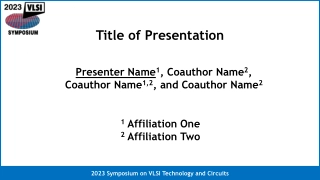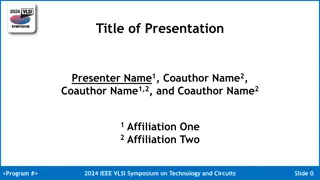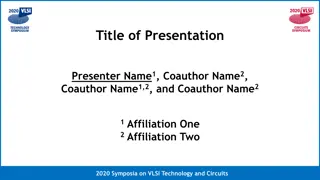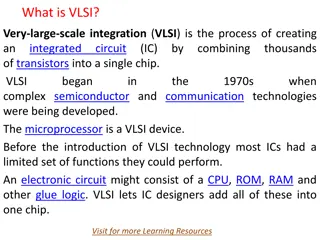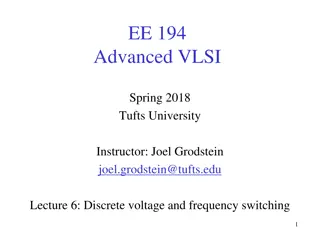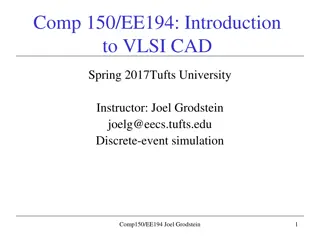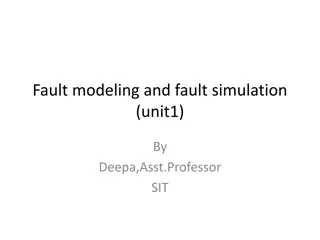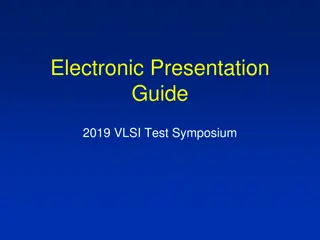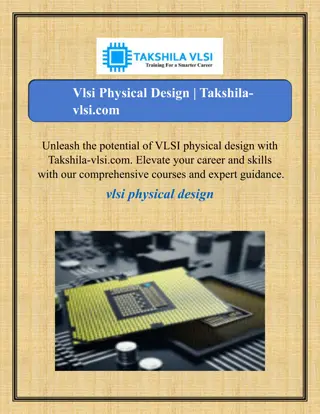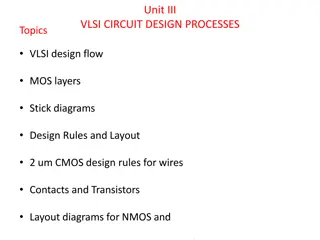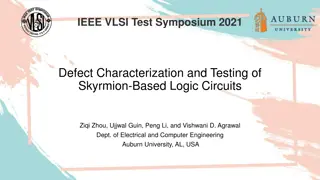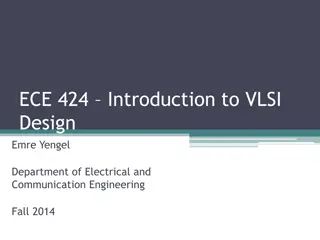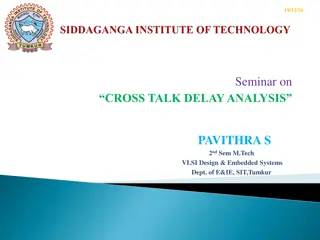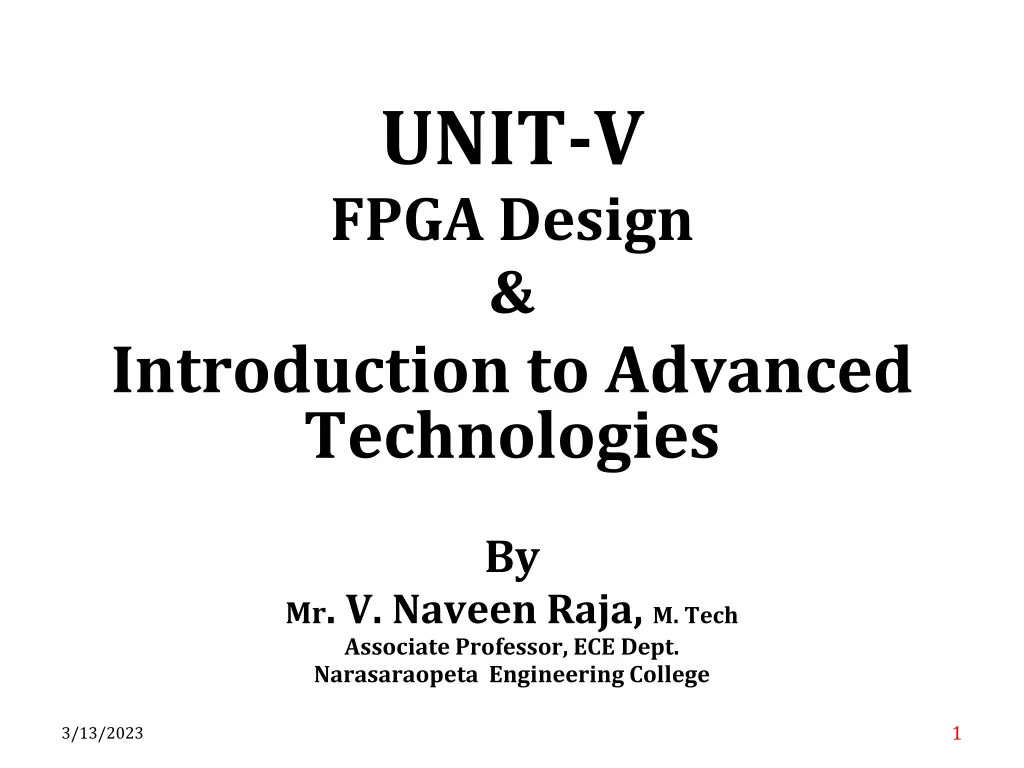
Introduction to FPGA Design and Advanced Technologies
Explore FPGA design and advanced technologies in this informative content covering FPGA architecture, VLSI design flow, and programmable logic devices. Learn about FPGA arrays, interconnects, and logic blocks in VLSI design. Discover key concepts like Look Up Tables (LUTs) and interconnect wire segments in FPGA architecture. Gain insights into FinFET, TFET, and other advanced technologies for FPGA design.
Download Presentation

Please find below an Image/Link to download the presentation.
The content on the website is provided AS IS for your information and personal use only. It may not be sold, licensed, or shared on other websites without obtaining consent from the author. If you encounter any issues during the download, it is possible that the publisher has removed the file from their server.
You are allowed to download the files provided on this website for personal or commercial use, subject to the condition that they are used lawfully. All files are the property of their respective owners.
The content on the website is provided AS IS for your information and personal use only. It may not be sold, licensed, or shared on other websites without obtaining consent from the author.
E N D
Presentation Transcript
UNIT-V FPGA Design & Introduction to Advanced Technologies By Mr. V. Naveen Raja, M. Tech Associate Professor, ECE Dept. Narasaraopeta Engineering College 1 3/13/2023
CONTENTS: PART-A: FPGA Design VLSI Design flow FPGA design flow Basic FPGA architecture FPGA Technologies PART-B: INTRODUCTION TO ADVANCED TECHNOLOGIES: Giga-scale dilemma Short channel effects High k Metal Gate Technology FinFET TFET 3/13/2023 2
VLSI Design flow 3/13/2023 4
FPGA Design flow FPGA programmable logic devices. provide the next generation in the The word Field in the name refers to the ability of the gate arrays to be programmed for a specific function by the user instead of by the manufacturer of the device. The word Array is used to indicate a series of columns and rows of gates that can be programmed by the end user. 3/13/2023 5
FPGA Architecture FPGA contains a two dimensional arrays of logic blocks interconnections logic blocks. and b/w Both the logic blocks and interconnects are programmable. Logic programmed implement a desired function interconnects programmed using the switch boxes connect the blocks. blocks are to and the are to logic 3/13/2023 6
CLB The logic block consists of one Look Up Table (LUT) and one FlipFlop. An LUT is used to of implement different functionality. The input lines to the logic block go into the LUT and enable it. number The output of the LUT gives the result of the logic function implements output of logic block is registered or unregistered output from the LUT. that and it the SRAM implement a LUT. is used to 3/13/2023 7
Interconnects A wire segment can be described as two end points of an interconnect with no programmable switch between them. A sequence of one or more wire segments in an FPGA can be termed as a track. Typically an FPGA has logic blocks, interconnects and switch blocks (Input / Output blocks). Switch blocks lie in the periphery of logic blocks and interconnect. Wire segments are connected to logic blocks through switch blocks. Depending on the required design, one logic block is connected to another and so on. 3/13/2023 8
xbar Switches Used to connect vertical and horizontal wires. When a wire enters into a switch box, there are three programmable switches that allow it to connect to three other wires in adjacent wires. Connection Box Used to connect adjacent switch box, CLB with vertical and horizontal wires. I/O Pads These input and Output pads are used for signal conditioning at chip input and output lines. 3/13/2023 9
FPGA Advantages Design cycle is significantly reduced. A user can program an FPGA design in a few minutes or seconds rather than weeks or months required for mask programmed parts. High gate density i.e it offers large gate counts. No custom masks tooling is required (Low cost). Low risk and highly flexible. Reprogram ability for some FPGAs (design can be altered easily). Suitable for prototyping. Parallelism FPGA Limitations Speed is comparatively less. The circuit delay depends on the performance of the design implementation tools. The mapping of the logic design into FPGA architecture requires sophisticated design implementation (CAD) tools than PLDs. 3/13/2023 10
FPGA Technologies Basically there are three programming technologies are there for FPGA. Static RAM Antifuse Flash SRAM-based FPGAs They use a standard fabrication process that chip fabrication plants are always optimizing for better performance. Since the SRAMs are reprogrammable, the FPGAs can be reprogrammed any number of times, even while they are in the system, just like writing to a normal SRAM. SRAM devices can easily use the internal SRAMs as small memories in the design. The disadvantages of SRAM-based FPGAs are that they are volatile, which means a power glitch could potentially corrupt the contents of the device. SRAM devices have large routing delays and are slower than other technologies. 3/13/2023 11
FPGA Technologies Basically there are three programming technologies are there for FPGA. Static RAM Antifuse Flash Antifuse FPGAs These are non-volatile and the delays due to routing are very small, so they tend to be faster. Antifuse FPGAs tend to require lower power and they are better for keeping your design information out of the hands of competitors because they do not require an external device to program them upon power-up as SRAM devices do. The disadvantages are that they require a complex fabrication process, they require an external programmer to program them, and once they are programmed, they cannot be changed. 3/13/2023 12
FPGA Technologies Basically there are three programming technologies are there for FPGA. Static RAM Antifuse Flash Flash FPGAs Flash FPGAs seem to combine the best of both of the other methods. They are nonvolatile like antifuse FPGAs, yet reprogrammable like SRAM FPGAs. They use a standard fabrication process like SRAM FPGAs and they are lower power and secure like antifuse FPGAs. They are also relatively fast. Currently, one vendor supports flash FPGAs and another vendor has a hybrid flash/SRAM FPGA. They are not catching on as fast as I expected, though that could change in the future. 3/13/2023 13

